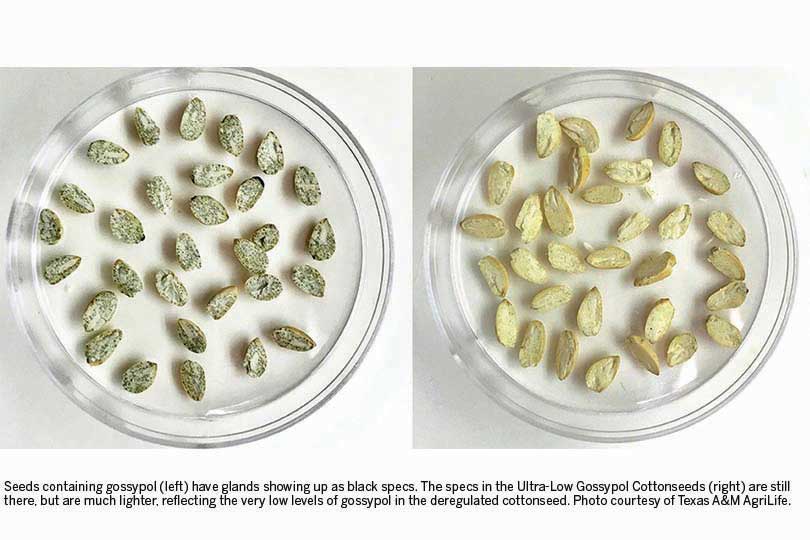By Jessica Domel
Multimedia Reporter
It has the potential to feed half-a-billion people and add value to the bottom line of cotton growers. And the new cotton variety just received approval from the U.S. Department of Agriculture (USDA).
“For only the fourth time in the history of the United States Department of Agriculture, they approved a new food source, and that is the cottonseeds that have been developed by Dr. Rathore,” John Sharp, chancellor of Texas A&M University, said.
The edible cottonseeds are the result of a life’s work by Texas A&M AgriLife Research plant biotechnologist Dr. Keerti Rathore.
“Dr. Rathore came here about 23 years ago, and one of his projects—he was actually working with the very famous Dr. (Norman) Borlaug at the time—was to try to figure out how you get the toxin, gossypol, out of cottonseeds,” Sharp said.
Rathore wanted to remove the gossypol from the seeds in the plant so animals other than cattle can safely consume them.
“Basically, what he has done is silence the toxic gene in the cottonseed. He has kept the gene in the plant, so that animals can’t graze the cotton, and bugs and things like that would not eat the leaves,” Sharp said.
Gossypol is a naturally-occurring compound in the pigment of cotton plants, according to USDA. It protects the plant from pests and diseases.
The cotton variety developed by Rathore maintains the protection needed for the fiber of the crop while significantly reducing the gossypol in the cottonseed.
“If you look at a cotton plant, for every pound of cotton fiber it produces, it produces about 1.6 pounds of seed. So, the seed, according to AgriLife Research, once this becomes commercial, should become equally valuable as the cotton,” Sharp said. “In other words, it should be able to double the income of cotton farmers.”
If you take all the cotton grown in the world currently and convert it to the Texas A&M cotton variety, you would be able to feed between 500 and 600 million more people with daily protein requirements.
“This cottonseed is very high in protein. We’ve known that forever. It makes cattle just fat as butterballs,” Sharp said. “Now that we’ve gotten USDA approval, we’re starting the commercialization process. That cotton will be grown here and in different parts of the country, in order to get enough seeds to make it commercially viable and get it out as fast as possible for farmers use.”
Rathore’s development will lower cottonseed oil refining costs, according to USDA.
It will also allow cottonseed to be eaten, ground into flour or made into a peanut-butter like spread.
“It’s going to really be a boon to the cotton industry, which you know, is huge in Texas,” Sharp said. “I’m really proud of these folks for sticking with this for so long until they finally mastered it.”
People have been looking for a way to make cottonseeds edible since 1915.
“They found a breed of cotton the Hopi Indians were growing, out in the deserts of Arizona, and this research stemmed from trying to improve on what that particular cotton was about,” Sharp said. “Dr. Rathore just stuck to it until he finally cracked the code.”
The patent is pending on the cotton variety, but Sharp said it is not the university system’s intention to make money for the university off of it.
“This is something that Dr. Rathore wants as a gift to the country without restricting people to do it,” Sharp said. “The only reason we patented it is (because) we want to make sure we control the product and that it’s done in the right way. It’ll be a huge food supply for the rest of the world.”
The university system is already getting calls from across the globe wanting to know when it’s going to be commercially available.
It’s unclear how long the commercialization process will take, but Sharp said he suspects it will take the better part of a decade.
“The research in the last five, six years or so was paid for by Cotton Incorporated, so we’re real thankful to Cotton Incorporated for helping us bring this online,” Sharp said.
The Food and Drug Administration is expected to approve the cotton variety in the coming months.

